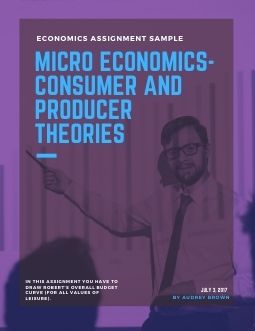You can download the sample Economics essay on Consumer and Producer Theories with the following question for free at the end of this page. For further assistance with Economics Assignment help, please check our offerings in Economics assignment solutions. Our subject-matter experts provide online assignment help to Economics students from across the world and deliver plagiarism free solution with a free Turnitin report with every solution.
(AssignmentEssayHelp does not recommend anyone to use this sample as their own work.)
Economics Assignment Question
Robert is currently single, unemployed and leaving alone. He is receiving government allowance (similar to Newstart) but looking for a job. He found a job that pays $15 per hour, but he is confused how accepting the job will affect his entitlement to the government assistance. Your job is to help Robert to figure it out. (Allowance is usually per fortnight, but we will look at per day for simplicity).
a) Suppose that Robert has 24 hours a day available for work and leisure. If he doesn't work at all, he receives $81 per day from the government (that includes opportunity cost of rent assistance and health care card, but for simplicity let's assume that he just gets that much cash). He can spend these money on 'other goods', which have price equal to one. Show this point A on a diagram with leisure on horizontal axis and 'other goods' on vertical, as in lecture 3.
b) If Robert earns less than $9 per day in his job, he can keep all his allowance and his earnings from the job. How many hours and minutes would it take him to earn $9? Show new point B (where he earns $9) on the same diagram as in a).
c) If Robert earns more than $9 but less than $21 per day in his job, he will lose 50c for each dollar earned between $9 and $21. For example, assume that Robert earns $13 per day. Then his government allowance will decrease by (13-9)*0.5 = $2. How long will it take Robert to earn $21? How much money is available to spend on other goods in that case? Show new point C on the diagram.
d) If Robert earns more than $21 but less than $96 per day in his job, he will lose 70c for each dollar earned between $21 and $96. That's in addition to 50c per dollar loss for $9 to $21 range. If he earns $96, how much leisure is he enjoying? How much money is available to spend on other goods? Show this point D on the diagram.
e) If Robert works even one minute more than at point D, he will lose all government allowance. Draw his budget line when he works more than at point D.
f) Draw Robert's overall budget curve (for all values of leisure).
g) Draw Robert's indifference curves such that he prefers to accept full time job (8 hours per day). Please assume he has “standard” preferences – more is better, with decreasing MRS (convex preferences). Show his optimal choice on a diagram.
h) Peter (who otherwise is exactly in the same situation as Robert) earns just under $96 per day from his job. Draw several Peter's indifference curves and show his optimal choice on a diagram.
i) Mary (in similar situation to Robert and Peter) earns $19 per day from her part time work. Draw several Mary's indifference curves and show her optimal choice on a diagram.
j) In your opinion, does this government allowance program encourage or discourage people from working? (no more than 500 words; please aim for 300 words)
Cheburashka uses kiwi fruits (K) and labour (L) to produce juice (q).
His production function is:
q = min {L0.5, K/3},
where labour is measured in hours, kiwi fruits in kg, and juice in (large) bottles. For example, if he uses 3 kg of kiwi fruits and spends 1 hour, he can produce 1 bottle of juice.
a) Derive an expression for Cheburaska's expansion path. How does it depend on the wage and the price of kiwi?
b) Draw the expansion path and isoquants for q = 1, q = 2 and q = 3 on a diagram with labour on horizontal axis and fruits on vertical.
c) Let the price of labour-hour be given by w = $20 and the price for each kg of fruit be given by p = $4. What is the optimal amount of labour and fruit to use to produce q bottles of juice, if Cheburashka strives to minimise costs? Illustrate on the graph from b) by drawing corresponding isocost lines.
d) What is Cheburashka's long-run total cost function?
Micro Economics Assignment Solution on Consumer and Producer Theories
Robert is currently single, unemployed and looking for a job. He has found a job that pays him a wage (r) of $15 per hour. He has a total time (T) of 24 hours a day available for work (W) and leisure (L). His income from both the mediums is taken together in the vertical axis.
a) Robert gets a Government allowance (G) of $81 per day if he doesn't work at all. With this money, he can buy 'other goods' which have a unit price. The diagram showing the point A, where Robert enjoys 24 hours of leisure and earns $81 a day is as follows: (Fig.1)
b) If Robert earns less than $9 per day, in his job, he can keep all his allowance as well as his earnings from the job. Robert has a job that pays $15 per hour. Thus, he earns $9 in (1/15) x9 hours, i.e., 3/5 hours or 36 minutes. The following diagram (Fig.2) shows the point B, where Robert earns $9 from his job and enjoys 23.4 hours of leisure:
c) If Robert earns anything more than $9 but less than $21, then he'll lose 50c for each dollar of the Government allowance earned between $9 and $21. Now, by the unitary method, it takes Robert (1/15)x 21 hours, i.e. 84 minutes or 1.4 hours to earn $21 in his job. In that case, he will lose $(21-9)x0.5 = $6 from the government allowance. His total remaining income (both from job and allowance) is $(81-6)+$21 = $ 96. The point C in the following diagram (Fig.3) shows that $96 is available to be spent on other goods by Robert, while he can enjoy (24-1.4) = 22.6 hours of leisure.
Other goods (in $)
d) If Robert earns more than $21 but less than $96 per day in his job, he will lose 70c for each dollar earned between $21 and $96. That's in addition to 50c per dollar loss for $9 to $21 range. If Robert earns $96 from his job, it'll take him (1/15)x96 hours, i.e., 6.4 hours of working. Then he can enjoy (24-6.4)=17.6 hours or 17 hours and 36 minutes of leisure. In this case, he loses an extra $(96-21)x0.7= $52.5 along with the previous $6. Hence, his remaining government allowance is $22.5 and the amount of money that he has left to spend on other goods is $(22.5+96) = $118.5. The point D in the following diagram (Fig.4) shows Robert's current amount of leisure and money for other goods:
(Some parts of the solution has been blurred due to privacy protection policy)



 WhatsApp Us
WhatsApp Us